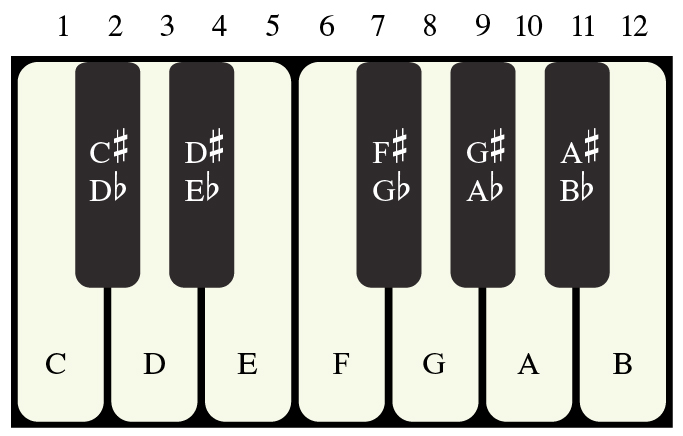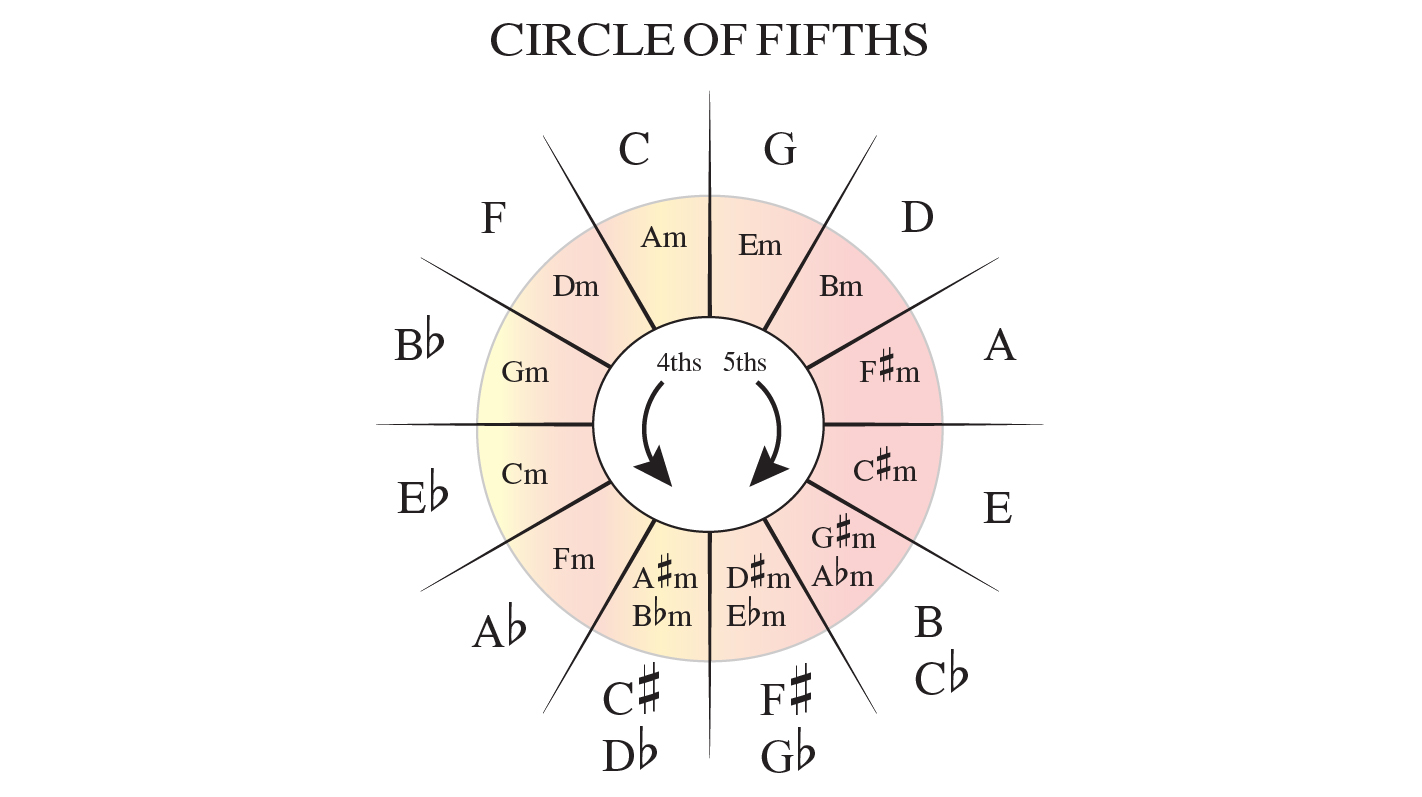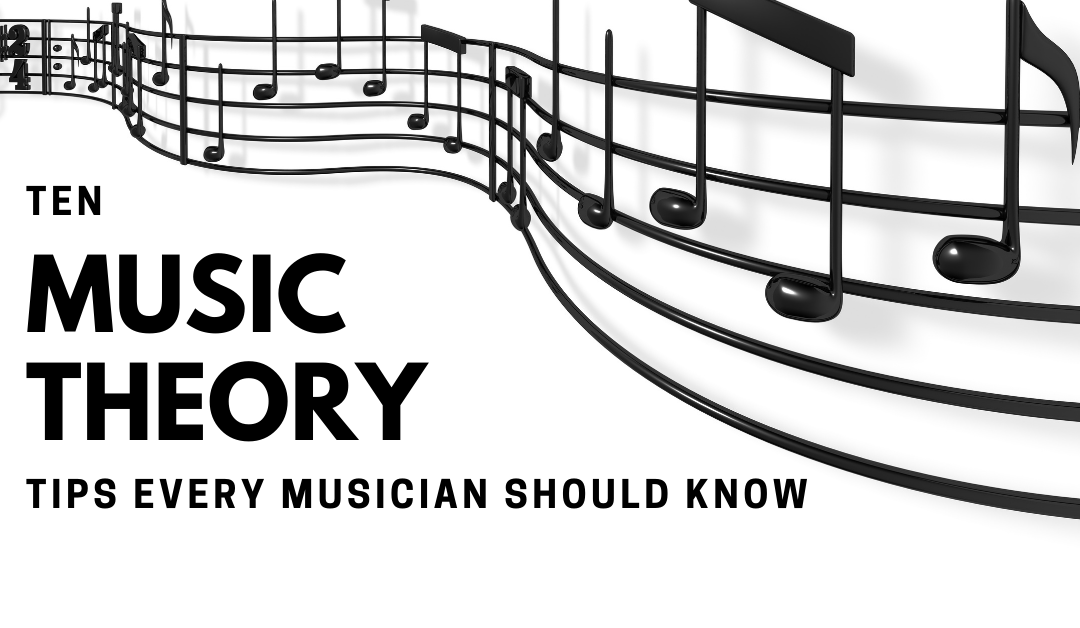As complex as music theory may seem, always keep in mind, “theory is a means to an end” and not an end in itself. In other words, theory can only take you so far. Eventually, to play music, try to lock into the song’s particular feeling and play from the heart. As the saying goes, “those who know it, feel it.” Here are ten theory tips every musician should know:
TIP #1 – There are 12 notes in music, and each of these notes can be a key:
| A | A#Bb | B | C | C#Db | D | D#Eb | E | F | F#Gb | G | G#Ab |
| 1 | 2 | 3 | 4 | 5 | 6 | 7 | 8 | 9 | 10 | 11 | 12 |
Here are these 12 notes on the piano keyboard:

And the same 12 notes on a single string of the guitar:

Since there are 12 notes in music, and each note can be a key, there can be 12 major and 12 minor keys. For example, there is a key of A major and A minor, a key of D major and D minor, etc.
“those who know it, feel it; those who feel it, know it”
.
TIP #2 – Figure out the key(s) of the song you will be jamming to. In popular music, keys generally fall into two groups: major or minor. If you are unsure, ask yourself, “what chord is prominent throughout the song”? Also, check the song’s last chord as they often end on the song’s key. etc.
TIP #3 – Once you have the key figured out, you can sort out the scales that go with the song’s chords. This is a little trickier to solve but start with the scale that goes with the key you are in. For example, if you are in D major, use a D major scale; if you are in D minor, use the D minor scale, and if you are playing a blues in D, then use a D blues scale. If life were so simple! Unfortunately, many scale possibilities exist for each chord in a song, but simple is often the best choice.
For a few simple improvisation techniques on a 12 bar blues check this post out by Brad Eaton.
Diatonic triads and seventh chords
TIP #4 – From the seven notes in a major or minor scale, you can build chords on each note. Here are the notes in the C major scale:

Then on each note, we can build a three-note chord called a triad:

These chords are called “diatonic chords,” meaning they are chords from the key. Notice there are three chords produced: major, minor and diminished.
You can also form chords on a minor scale. Here are the diatonic chords in the key of Am:

In blues music, we often use 7th chords. Here are the diatonic 7th chords built on the C major scale::

TIP #5 – Learn the primary and secondary chords in each key. Certain chords are prominent in every key. For example, in the key of C, the prominent or “primary” chords are on the 1st – C major, 4th – F major, and 5th – G major degrees of the scale. The secondary chords are the 2nd – D minor, 3rd – E minor, 6th – A minor. The diminished chord is not commonly used but acts more like a minor chord.

Scales and Modes
TIP #6 – As mentioned, there are many scale possibilities (hundreds). Still, the blues and pentatonic scales are most common for guitar players. The blues scale is the swiss army knife that works for most blues tunes, so become an expert at all blues patterns. Learn to move from scale pattern to pattern and avoid playing exclusively in the vertical “box” shape. The patterns work great and are reasonably easy to memorize but can get old pretty quickly if you repeatedly reuse the same riffs.
“Sound is what drives my solos, not verbal concepts, I never think ‘I’m going to use a Lydian Dominant scale and then go up a half-step’, even though that might be exactly what I end up doing.”
.
TIP #7 – ” Modes” are another set of scales available and a nice change from the blues scales. If you know the major scale, then you also know the modes. To play a mode, just play the major scale but start on a different note. There are seven notes in a major scale and therefore seven modes. Here are all the modes from the key of C:
1 – C D E F G A B C – Ionian (Major)
2 – D E F G A B C D – Dorian
3 – E F G A B C D E – Phrygian
4 – F G A B C D E F – Lydian
5 – G A B C D E F G – Mixolydian
6 – A B C D E F G A – Aeolian (Minor)
7 – B C D E F G A B – Locrian
Notice, the modes use the same notes as the C major scale but start on a different note for each mode. So, C Ionian (which is the same as C major) goes from C to C. D Dorian, goes from D to D, etc. I’d like to point out that modes are unique sounding and not just part of the major scale. If you play the D Dorian mode with a D minor chord, you will get the idea. The Mixolydian mode is often used in blues and jazz soloing.
The Circle of Fifths
TIP #8 – You may have seen the circle of fifths before but wondered how it can help. The notes or keys are arranged five letters apart (perfect fifth interval) going clockwise and four letters apart (perfect fourth interval) going counterclockwise.
If we look at a traditional 12 bar blues, the three chords in the key of C are:
D is the 1 chord, G is the 4 chord, and A the 5 chord.
Now look at the circle of 5ths/4ths and spot the D, G and A. You will see the G and A are one-note above or below the D. So one use of the circle is to figure out the chords in any 12 bar blues. Also, take notice of the minor chords to play in minor keys.
The circle is handy for understanding chord progressions but can also be used to practice scales. For example, you could practice a scale, say D blues, then transpose it to the next note in the circle, which is A. So, you can apply this method to practice all the scales by going up by fifths or down by fourths.

TIP #9 – Learn each note in the chords. The notes in a chord are also called arpeggios or chord tones, as I will refer to them. So in a D major chord, the notes are D, F# and A. In a D minor chord, the notes are D, F and A. It is essential to know the chord tones of the chords that are played while you solo. For example, here are the chord tones in a 12 bar blues in D:
D7 = D F# A C – G7 = G B D F – A7 = A C# E G
So, when the D7 chord is being played, you can always play one of the chord tones, and it will sound fine or, in music terms: stable.
“Works of art make rules; rules do not make works of art.”
.
Rhythm subdivisions
TIP #10 – Know the time signature. I’ve noticed that beginner players are often unsure of the time signature the song is in. The most common time signature is 4/4 time, meaning 4 beats per bar. 3/4 (3 beats per bar) and 6/8 (6 beats per bar) time are also used but less frequently. If you struggle with rhythm, start counting in your head (1, 2, 3, 4), tap your foot or buy a metronome or drum machine to play along with.
After you know the time signature, then learn all the subdivisions of the beat, meaning how many notes can I play in each beat. This little chart shows the subdivisions of the beat:

The whole note = 4 beats, the half note = 2, the quarter note = 1, the eighth = 1/2, the triplet = 1/3, and the sixteenth = 1/4 of a beat. For variety, always try to use a combination of different rhythms when you create your riffs and solos.
As stated earlier theory is a means to an end, not the end itself. I’ve found playing with other musicians either professionally or as an amateur surpassed any textbook theory I learned at school. In fact, here are my three tips to become a better musician.
DROP D (DADGBE) Guitar Chords and Fingerboard Posters
This two-poster guitar chord set is an excellent reference for creative guitarists exploring the world of Drop D altered tunings.
Blank Guitar Tablature Collection
The 6-String Blank Tablature Workbook and Reference Collection for Guitar include eight blank templates and a useful reference with chords, scales, fingerboard, and more. Multi-Tab Workbook and Reference for Guitar 155pgs.
PDF Ebook also available so you can print as many blank tab pages as you like. Add to cart for the PDF or buy from Amazon for the print book.
Improve Your Guitar Chord Playing
In Improve Your Guitar Chord Playing – Chord Switching Tips, Tricks & Exercises, you will learn the essential skills required to master the most frequently used chords. Discover valuable lessons and exercises to play faster, precise sounding chords and an improved 3-way visual chord learning system with tests to help remember chords.




Recent Comments